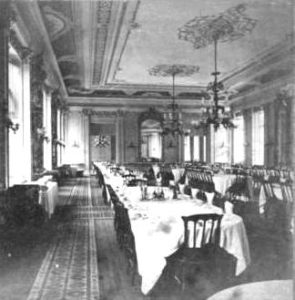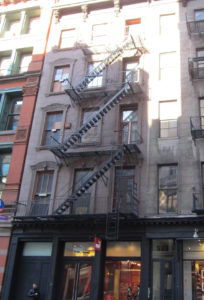The St. Nicholas Hotel, on the west side of Broadway between Spring and Broome Streets, was a hotel like nothing New York City had seen before. It was said to have ended the reign of the Astor House, on Broadway at Vesey Street, as the preeminent New York hotel.
Opened on January 6, 1853, The New York Times reported that “[t]his magnificent establishment, which in extent of accommodation, completeness of arrangement, costliness and chaste elegance of decoration, and combination of all modern improvements, takes place as the Hotel par excellence of our day..”
When it first opened, the St. Nicholas stretched from Broome Street 100 feet toward Spring Street, and within a year the hotel was extended to the end of the block. The six-story building was of Italian architecture with Corinthian elements.
Touting a marble lobby with frescoed ceiling, the St. Nicholas was the first building in New York City to cost over $1 million to build (and cost another $700,000 to furnish). Accommodating over 1,000 guests per week, it had several dining rooms, a reading room illuminated by an ornate, gilded and domed skylight, an elaborate men’s hair-cutting salon with gilded domed skylight, a gentlemen’s drawing room, among numerous other amenities.
In addition to hosting high profile guests and lavish celebrations, the St. Nicholas was also the scene of various high-profile crimes, including robbery, forgery, conspiracy, attempted murder, and two murders.

By the late-nineteenth century, the hotel declined in popularity as the City expanded ever farther uptown and the Fifth Avenue Hotel on Broadway at 23rd Street, became known as the newest “finest hotel in New York City.”

Remnants of the St. Nicholas Hotel at 521 Broadway
From the 1870s on, the hotel was converted to other uses: The Snook-designed Loubat store (503–511 Broadway) took the southern wing in 1878 and the central portion of the building (513–519 Broadway) became Samuel Warner’s store and warehouse in 1884. (source: Wikipedia)
The St. Nicholas Hotel permanently closed in 1884, and only a small sliver of the original hotel building was preserved when it was demolished in the early 20th century. The only remaining part of the original building is on the upper façade of 521 Broadway, where the windows still have their original ornamented moldings.